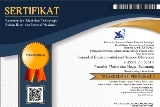Mapping the Dynamics of Mangrove Density in Alas Purwo National Park using the ARVI Index
DOI:
https://doi.org/10.15294/jese.v4i1.5721Keywords:
Remote Sensing, Landsat-8, Mangroves, Radiometric Correction, ARVIAbstract
This study aims to compare the sensor/Top-of-Atmospheric (TOA) reflectance correction method and surface reflectance correction in the ARVI (Atmospherically Resistant Vegetation Index) vegetation index transformation application. The resulting comparison of the two has a correlation that is not much different, sensor reflectance correction (R = 0.9723) and surface reflectance correction (R = 0.9781) are both able to represent mangrove forest canopy density well. The model accuracy resulting from the surface reflectance correction RMSE 1.408 and MAPE 0.48%, is higher than that of the sensor correction (TOA) which has an RMSE value of 2.184 and MAPE 1.34%. For advanced remote sensing analysis, it is better to perform radiometric correction of surface reflectance because the reflectance value used for analysis is the true reflectance value. The condition of mangroves in Grajagan Bay in Alas Purwo National Park is very well preserved, this is shown by the mangrove canopy density >50% increased by 49.11 Ha in a period of 7 years from 2016 to 2023.
